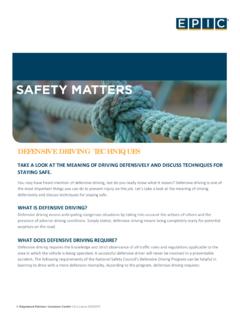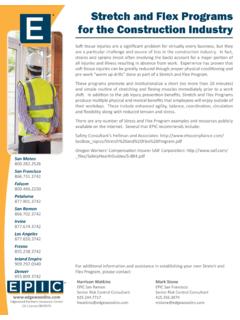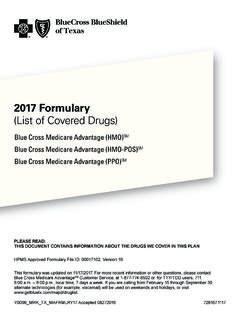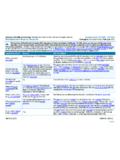Transcription of +RR OMM P Manager Makes Money - …
1 Edgewood Partners Insurance CenterCA License 0B29370 Dennis Tumminia, LUTCF, PHIASP rincipal, Employee Benefits135 Main Street, 21st FloorSan Francisco, CA Your Pharmacy Benefit Manager Makes Edgewood Partners Insurance CenterCA License 0B29370 February 14, 2013 When you sit down to negotiate with a Pharmacy Benefit Management company (PBM), do you know how they make Money ? If not, you re not alone. Since 1991, the year rebates came into the revenue equation, understanding where PBM revenue comes from has become an increasingly difficult task.
2 Knowing how a PBM Makes Money will make you a more effective , PBM s employ a balloon strategy in their price negotiations; if you squeeze one element of the pricing matrix, another element pops out. Ask for a lower dispensing fee and the Specialty Rx pricing becomes non-negotiable. Ask for a lower brand discount and rebates begin to s use a per script net revenue model that combines all revenue elements and if you are going to be successful in your negotiations, you need to understand what the elements are and the revenue associated with each.
3 Only then can you can get your hands around the entire PBM revenue elements, like Clinical Prior Authorization fees, are highly visible. Others, like rebates, are shrouded in confidentiality agreements. And still others, like generics, are a total mystery. Where DOES a PBM make Money ?Retail Pricing ElementsAdministrative Fees- this is the fee charged by the PBM for the electronic processing of each claim. In an attempt to gain a competitive advantage and competitive spread sheeting , these fees have disappeared in traditional pricing pass through pricing models, these fees can range anywhere from $ to $ per script.
4 This represents the entire profit for the PBM- or does it?Even in a pass through model, there is hidden revenue in the form of transaction fees the PBM is charging retail pharmacies for each claim they submit. These fees are typically between $ per claim. This doesn t seem like much, but is another example of how you can be nickel & dimed outside of the visible charges in a PBM contract. Brand Ingredient Costs- the list price for all drugs is called the Average Wholesale Price or AWP. Typical discounts for brands range from AWP-13% to AWP-17%.
5 In a traditional model a PBM might contract with a retail pharmacy chain such as CVS at AWP-18% and then offer you a contract discount of AWP-17%, keeping the difference for them self. This is called a pharmacy withhold or differential pricing . Each percentage point of withhold is worth approximately $ per script. The withhold or spread between what the PBM pays the pharmacy and what they charge you used to be much greater, but competitive forces have driven brand discounts deeper in recent years, reducing the PBM profit margin on these Ingredient Costs- generic discounts are priced in one of two ways; (1) as an AWP discount, or (2) at a Maximum Allowable Cost (MAC).
6 There is usually a large gap between these pricing elements, as generics are, along with pharmaceutical manufacturer revenue (which we will talk about later in this article), are the main sources of PBM revenue. PBM s typically make in excess of $ per prescription. If you are not going to conduct a full file re-pricing of your historical claims, consider asking your PBM to price out the top 50 generics used in the previous year, giving you both the list price and the discounted price for these drugs and indicate whether each drug has a MAC or AWP discount price.
7 This will help you understand how extensive the PBM MAC pricing list is. This is important to know, as MAC pricing is much deeper than AWP discount pricing or generics: MAC pricing should average AWP-80%. AWP discount pricing typically averages AWP-26%*Note that a strong pricing offer would be MAC over 95% of all generic drugs Edgewood Partners Insurance CenterCA License 0B29370 Dispensing Fees- contractually, these fees can range from $ to $ per prescription. A PBM contracts with pharmacies for $ to $ below these rates.
8 Interestingly, all Usual & Customary (U&C) pharmacy claims are processed with no dispensing fee. Before you agree to a final contract dispensing fee, ask your current PBM how many U&C claims you had in the previous plan year. This will help you understand the impact these claims had in reducing your average historical dispensing fee cost to the PBM. If your U&C claims were greater than 10%, ask for a dispensing fee of a $ or less. Rebates- you may be offered rebates in a dizzying variety of ways: as a percentage, a fixed amount, on a per formulary brand basis, or on a per script basis.
9 Here are some simple negotiating devices that will help you insure a fair rebate amount: Always negotiate fixed dollar rebate guarantees. If the PBM insists on a percentage, ask for the greater of a fixed dollar amount or a percentage. Always negotiate rebates paid on a per script basis. If this is not acceptable to the PBM, then fall back to a per brand script rebate guarantee. Always ask if rebates are subject to any Days Supply or Formulary Percentage criteria. Together these criteria can reduce the guarantee by up to 10%, so a $30 rebate guarantee will only be $ summary, ask for fixed dollar rebate guarantees on a per script basis across all scripts at both retail and mail.
10 Rebate values vary by plan design and size. Three tiered co-payment plans with at least a $15 co-pay difference between the 2nd & 3rd tiers drive greater rebates, typically $ to $ more per script. Mail Order Pricing ElementsAdministrative Fees- There should be no administrative fee for mail order Ingredient Costs- In essence, a PBM becomes a drug store when filling a mail order prescription. Therefore, how they make Money at mail order doesn t vary significantly with how a drug store Makes Money at retail. Typical discounts range from AWP-20% to AWP-24%.



